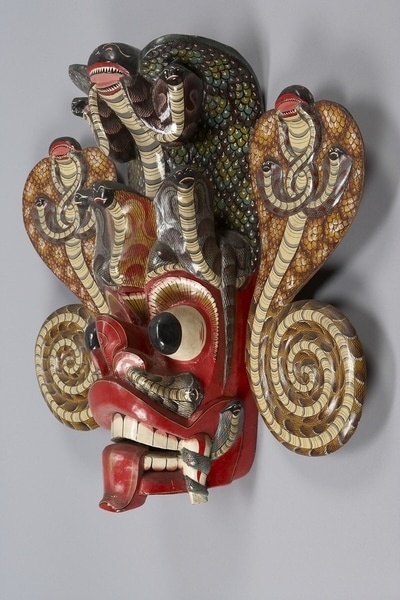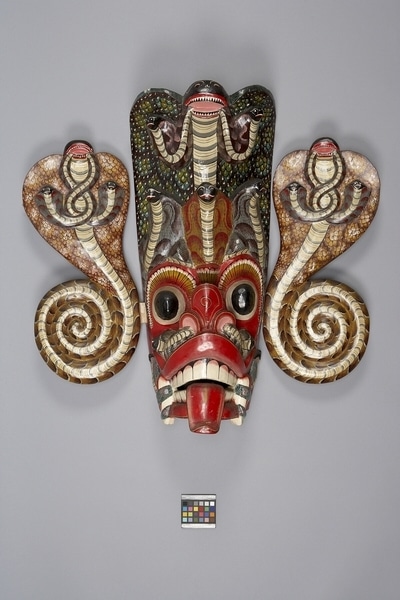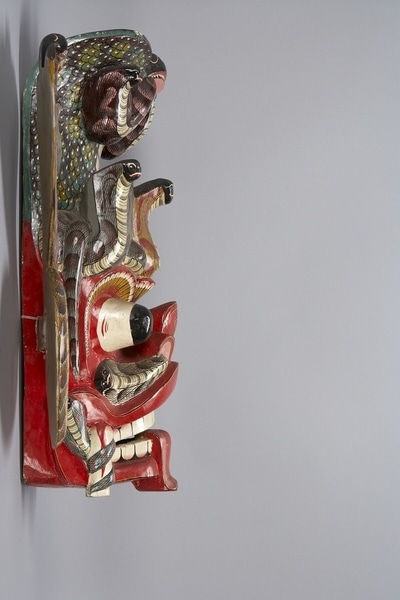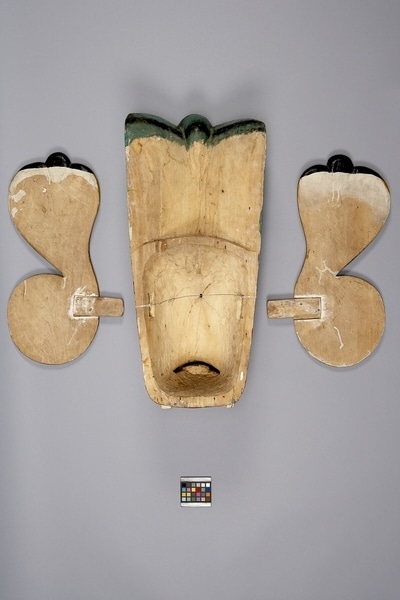Mask Item Number: Eh110 a-c from the MOA: University of British Columbia




Description
Humanoid face, glossy red, surmounted by green cobra headdress (a) with two detachable ear appendages, (right ear: b; left ear: c) each a coiled cobra with others emerging from either corner of mouth that attaches into a hole in the mask via an unfinished tenon. The eye sockets, and the area at the root of the nose are embellished with petal motifs. The white eyeballs with black pupils project in an exaggerated conical form. The upper lip is drawn back from the open mouth. Two rows of white teeth are exposed with a lolling red tongue. There is a large white fang extending down from each corner of the mouth. The cobras on the brow and at the top of the head each have their hood extended and are painted with faces. The scales are rendered in lines on varying background colours of grey, light red, dark red, and yellow. The body shield plates are in grey and white stripes. The cobras issuing from the mask's nostrils wrap around the fangs.
History Of Use
There are 2 major dance/drama forms in Sri Lanka: one is the Sanni, a healing and exorcising ritual, the other is the Kolam, a secular entertainment which has considerable elements of social satire. The Kolam incorporates narrative, mime, dance and music. Demons of a very malevolent nature appear in the Sanni, while those associated with the Kolam of the Naga Raksa, the snake demon being one, are regarded as semi-benevolent. Nevertheless, Naga Raksa may also be regarded as the embodiment of the destructive power of snake poison. The Kolam performance usually has 4 episodes, the precise content of which may vary. These consist of a prelude, detailing the origin of the drama; the arrival of a royal party and dances by characters demonic, mythical, human and animal; enactment of a popular story or stories; and a purifying demon dance. Naga Raksa appears in the second episode. His exact purpose is obscure although in company with his fellow demons he provides counterpoint to the comic episodes which follow.
Iconographic Meaning
Protruding tongue, nostrils turned to front in animal fashion, fangs, cobras with extended hoods issuing from mouth, the nostrils and ears are all distinguishing characteristics of the snake demon, Naga Raksa. Petals indicate the metaphysical connection between the cobra and the lotus, based morphologically on their graceful, swaying, often intertwined forms; based symbolically on their abode in water and their common association with the Buddha.
Cultural Context
dancing
Item History
- Made in Sri Lanka
- Collected during December 1981
- Owned by Jason Schoonover before February 15, 1983
- Received from Museum of Anthropology Shop Volunteers (Funding source) and Jason Schoonover (Seller) on February 15, 1983
What
- Name
- Mask
- Identification Number
- Eh110 a-c
- Type of Item
- mask
- Material
- paint and nux vomica wood ?
- Manufacturing Technique
- carved and painted
- Part A
- height 74.0 cm, width 33.5 cm, depth 24.2 cm
- Part B
- height 55.0 cm, width 31.0 cm, depth 33.5 cm
Who
- Culture
- Sinhalese
- Previous Owner
- Jason Schoonover
- Received from
- Museum of Anthropology Shop Volunteers (Funding source) and Jason Schoonover (Seller)
Where
- Holding Institution
- MOA: University of British Columbia
- Made in
- Sri Lanka
When
- Collection Date
- during December 1981
- Ownership Date
- before February 15, 1983
- Acquisition Date
- on February 15, 1983
Other
- Condition
- good
- Accession Number
- 0868/0001 a-c